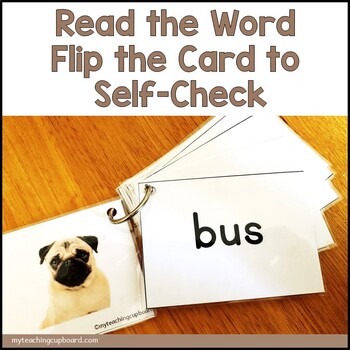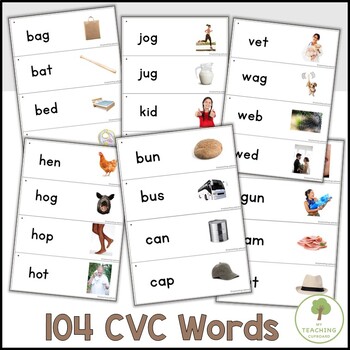CVC Word Cards with Self Checking Pictures – Flip Cards
- PDF
Description
These CVC word flip cards will build reading fluency and decoding skills. Your students will get lots of practice reading CVC words. There are 104 short vowel CVC words with matching self-checking pictures in this set. They include real-life photo illustrations so your children will easily relate to them.
THIS SET CONTAINS:
- 104 illustrated CVC word strips with matching real life photos
CHECK OUT THE PREVIEW TO SEE THE CVC CARD SAMPLES
When your children know all their single-letter sounds, they are ready to start decoding CVC words phonetically.
Build reading fluency with these CVC Word cards. They will help your students identify and blend the beginning, middle, and ending sounds in CVC (consonant-vowel-consonant) words.
These cards are self-checking. On each card is a CVC word, and on the back is a matching CVC picture. Students decode the word and then flip the card over to reveal the matching picture. Your students can check their reading accuracy independently.
HOW WE USE THESE CVC CARDS IN KINDERGARTEN:
This is one of my go-to reading activities with my kindergarten students. We use them mainly for buddy reading. Students work with a friend to practice decoding and reading the CVC word.
One child reads the first CVC word, and their partner listens. If the partner thinks the word has been decoded and read correctly, they tell their reading partner to “flip it”. The reader flips the CVC card over to reveal the matching illustration and gives the children an opportunity to self-check their reading accuracy.
The children then swap roles with the listening partner, becoming the reader and decoder.
PERFECT FOR:
- hands-on literacy centers
- small group literacy rotations
- buddy reading
- reading stations
- word work
- early finishers
- morning tubs
- homework
- or to inform your assessment grades
BOTH AUSTRALIAN AND AMERICAN SPELLING INCLUDED
Just print, cut, fold and laminate. Turn the cards into flip cards by putting them on a binder ring.
Easy prep and you’ll have a literacy resource you can use over and over in your classroom.
CVC Words Included:
- 26 short a words
- 16 short e words
- 17 short i words
- 20 short o words
- 25 short u words
My students have found this a fun and engaging way to practice reading CVC words.
Aligned to The Science of Reading:
Teaching your students to decode and read CVC (Consonant-Vowel-Consonant) words is a core principle aligned with the Science of Reading. This begins with learning phonics so students can decode and blend these words.
Decoding practice helps children grasp the sounds that individual letters make.
Research in the Science of Reading strongly advocates using CVC words as a foundational element in teaching early phonics and reading.
By focusing on these words, children can apply their understanding of letter sounds to read words correctly and that all helps strengthen their overall reading ability.
Want to be notified about product updates and new listings?
CLICK HERE to follow my store on TpT
Stay in touch with My Teaching Cupboard
And HERE on my blog





